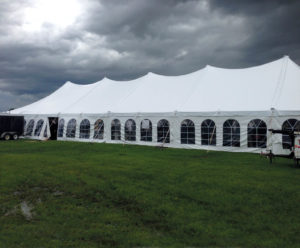
It’s human nature to seek cover in an emergency. A solid evacuation plan helps to ensure attendees of tented events find shelter in a safe location. (Hint: Not the tent!)
The collapse of the roof structure of a stage at the Indiana State Fair nearly five years ago served as a catalyst for discussions about safety and standards in the outdoor event industry. In response to that event, which killed seven people and injured dozens more, various jurisdictions invited input from industry experts in revising their codes, which has resulted in both improvements in safety measures and more knowledgeable code officials.
There also has been more widespread use of industry information such as studies on staking and ballasting from the Industrial Fabrics Association International (IFAI) and the evacuation planning guide from the American Rental Association (ARA).
Of course, there is always room for improvement, especially in education. Members of the industry and code officials need to better understand securement, and everyone else—event planners, authority figures and the general public—needs to recognize that tents are not safe shelters in severe weather. This includes excessive rain, hail, snow, ice, wind, lightning and flooding. Tents are also unsuitable shelters for other types of emergencies, such as a fire or explosion, infrastructure failures such as a gas leak, earth movement such as a tremor or landslide, civil unrest and active shooter situations.
Yet, people have a tendency to gather under tents in these circumstances. Why?
- It’s human nature to seek shelter in these situations. To a person uneducated in tent safety, it may seem that this is the reason for the tent in the first place.
- In the case of a remote installation, there may be no permanent shelter nearby.
- A tent installation may be larger than the nearest permanent structure. Guest count may exceed capacity of nearby buildings.
- Modern tents mimic permanent architecture, and elaborate event design gives guests the impression they aren’t in a tent.
An emergency evacuation plan takes these factors into consideration and educates users about the realities of tents as shelter.
 What is my responsibility?
What is my responsibility?
For all installations, tent rental businesses are responsible for performing adequate site surveys and site hazard analyses, providing equipment in good condition, adequately installing and securing tent equipment, developing emergency action plans for their employees while tents are installed and dismantled, and complying with the appropriate local, state and federal laws, regulations and guidelines. They are also responsible for warning renters that tents are not safe shelters and advising them to develop an emergency evacuation plan for their event. Skipping any of these steps can result in injuries and fatalities, insurance claims and a possible increase in premiums, litigation, punitive damages not covered by insurance, loss of inventory, loss of business and bad publicity.
Why is it the responsibility of the tent renter to tell the customer to have an evacuation plan? Tent manufacturers include warnings on tents that they are not suitable shelters. Some even mention evacuation plans. But the reality is that event participants are unlikely to look for warning labels, and labels are often obscured by decor.
As the middleman, a tent rental company has a legal duty to pass along any and all warnings and instructions provided by the manufacturer. (This is true of any product, not just tents.) That duty translates to warning that tents are not safe to use as shelter and advising to develop a plan to take adequate shelter in the event of an emergency.
With regard to requirements of the authority having jurisdiction (AHJ), tent renters should not assume information will get to where it belongs and must verify that each action item has been completed. A meeting with all parties will help to accomplish this.
AHJs generally don’t ask for all documents. They may ask for specific safety and planning documents. If they request a Life Safety Evaluation, the evaluation must be performed by someone acceptable to the AHJ and include a written assessment of specific elements, including:
- Nature of the event, participants and attendees
- Access, egress and crowd density
- Medical emergencies
- Fire hazards
- Permanent or temporary structures
- Severe weather
- Earthquake
- Civil or other disturbance
- Hazardous Materials Incidents within and near the venue
- Relationship between event operators, participants, EMS and other agencies (city office of emergency services, fire department, police department, contract ambulances and anyone who controls the emergency shelter access)
In addition to responsibilities related to the safety of event guests and the general public, tent renters are responsible for the safety of their own employees. For tent rental businesses in the United States, regulations related to employee emergency action plans on construction sites are covered in Standard Number 29 CFR 1926.35 from the Occupational Safety & Health Administration (OSHA). These regulations are federal law and not an optional activity. And remember, OSHA regulations reflect the minimum level of compliance, not the maximum.
Broaching the subject
What does an emergency evacuation plan for a tented event look like? And how is the need for a plan communicated to a tent rental customer? The rental contract should be used to ensure the customer understands a tent is not adequate shelter and agrees to evacuate the tents or temporary structures in the event of an emergency. It should include a clause that allows the rental company to dismantle the tent and/or cancel the rental when emergency conditions exist.
An effective emergency evacuation plan includes these principles:
- Authority and responsibility are clearly defined. A solid evacuation plan answers these questions: Who is in charge? When are they in charge? Who “owns” the day? Who makes the call?
- Action or trigger points are defined and non-negotiable. The plan defines what potential emergencies are being watched, such as weather or crowd behavior, and what events trigger a progression from a watch to a warning and a warning to an alarm.
- Training and communication are defined, carried out and documented. Everybody involved in the event knows his or her role in the plan and what he or she listens or watches for (such as an audible alarm, a public address system or code words).
- Alarms and resources are defined and accessible. When people react to an alarm, shelter must be accessible and egress paths clear. Attendees must have a way out and EMS must have a way in. The plan includes a means to account for all event personnel and guests.
Evacuation planning is a fact of (tent rental) life. Best practices are well established and resources are available for tent rental companies involved in all kinds and sizes of events.
By Maura Paternoster, risk manager, ARA Insurance Services Inc., and Ken Keberle, safety and training manager, Rhino Staging. This article was adapted from a presentation by Paternoster and Keberle at IFAI Tent Conference 2016.
Tent rental companies have implied legal duties to:
- rent only equipment in good condition
- properly erect/secure equipment
- provide instructions
- warn of “foreseeable risks”: this mean to advise the customer that tents are not designed to serve as shelter in emergency situations and recommend that the customer develop an emergency evacuation plan for their event.
Sample contract language
WEATHER-RELATED RISKS. Because the Tent is a temporary structure, it may collapse during a severe rainstorm, snowstorm or windstorm. Accordingly, in the event hazardous weather occurs or is credibly forecast, You agree to (a) cause all occupants to evacuate; (b) take such actions as We may reasonably request to protect; and (c) permit Our representatives to dismantle and store or retrieve, the Tent and/or any other Rented Items. YOU HEREBY ASSUME, AND AGREE TO PROTECT, INDEMNIFY, DEFEND AND HOLD HARMLESS THE RENTAL COMPANY (US) FROM AND AGAINST ANY AND ALL LIABILITIES, CLAIMS, DAMAGES, LOSSES, COSTS AND EXPENSES (INCLUDING WITHOUT LIMITATION, ATTORNEYS’ FEES) ARISING FROM OR ASSOCIATED WITH THE AFOREMENTIONED RISKS.
From the American Rental Association’s “Business Management: Contracts and Legal Guidelines” by James R. Waite, Esq.
Resources for evacuation planning
Statement of Best Practices of Emergency Evacuation Planning for Tented Events. Available from the American Rental Association, this resource covers:
- hazards and risks associated with temporary structures.
- why and how to train employees.
- when, how and to whom evacuation planning guidelines should be communicated.
- potential questions from customers, and suggested answers.
- guidelines and checklists for developing the plan.
- how communication with the customer will happen during an emergency.
ANSI E1.21-2013: “Entertainment Technology—Temporary Structures Used for Technical Production of Outdoor Entertainment Events.” This resource covers emergency planning and preparedness. View resource.
International Fire Code, chapter 4: “Emergency Planning and Preparedness.”
IS-15: “Special Events Contingency Planning.” Published by the Federal Emergency Management Agency.
Your insurance company’s risk management department.
 TEXTILES.ORG
TEXTILES.ORG


